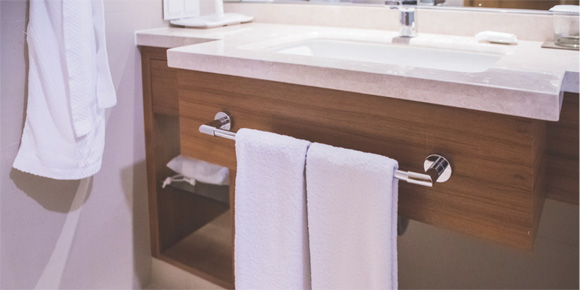by Arrol Gellner
Leaving seemingly trivial details to the last minute can often sabotage all your other good efforts.
In laying out a bathroom, for example, few people will take the time to decide exactly where the towel bars and toilet paper holder will go. How often have you used a bathroom where the toilet paper roll was on the wall directly behind you, requiring Houdiniesque contortions to reach it?
The only way to avoid such dismal outcomes is to decide in advance exactly where everything will go, right down to the smallest piece of hardware. For example, if you’re right-handed, the toilet paper holder should ideally rate a spot to the left of the toilet, about even with the front of the bowl, and about 30 inches off the floor. The opposite arrangement will work almost as well, though it’s less natural.
As for towel bars, you should reserve some unsullied wall space for at least one 18-inch bar for face towels and one 24-inch bar for bath towels (two of each is even better). Every robe hook, shoe rack, soap dish, clothes rod, or what-have-you in your project should get the same careful consideration.
Last-minute changes
Light switches, like toilet paper rolls, often end up in places they shouldn’t be, though it’s more often due to last-minute changes forced by jobsite conditions. People often assume they can fit a switch in any sliver of wall that’s as wide as the switch cover plate. Not so: The extra wall studs required around doorways and in corners often won’t leave enough room to squeeze in the necessary electrical box. Therefore, if you don’t want to end up having to move a switch to the wrong side of a doorway during construction, make sure you leave plenty of room between the door trim and any nearby obstructions. Multiple switches require correspondingly more breathing room.
On the exterior, downspouts are probably the most common accessory to suffer from benign neglect. I’ve seen many exquisitely designed homes despoiled at the last minute by tangles of ugly downspouts snaking hither and yon across the walls — all because the architect or owner didn’t find that lowly detail sexy enough to be worthy of careful attention.
Sweat the details
In this case, as in the others, you have to sweat the details — sexy or not. It shouldn’t be left for subcontractors to decide where the downspouts go, since they’ll usually just slap them up wherever it’s most convenient.
Instead, find out how many are required, and then scout out the best locations yourself. Don’t put downspouts on the front elevation if a less conspicuous spot is available. Avoid unnecessary offsets and angles, and on gutters that run along the side of the house, put the downspouts toward the rear corners of the house, not the front.
Take the same sort of care in locating gas and electric meters, plumbing vents, flues, and all the other incidental bric-a-brac that can clutter up a home’s exterior. Place them out of sight, or at least where they won’t be visually obtrusive. Make sure they end up where they do for a reason, and not just because no one was paying attention.
— Inman News.



